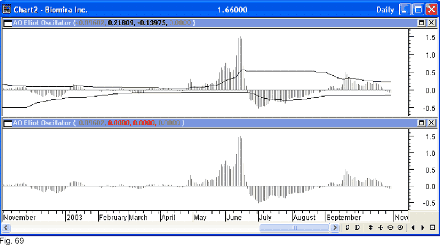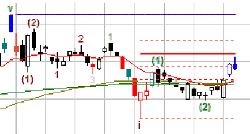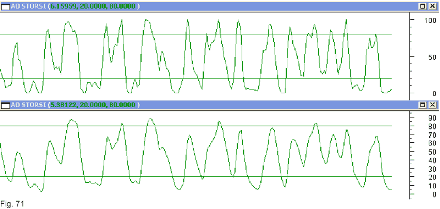List of AO Indicators for MetaStock for Windows
This is not an exhaustive list, only the key indicators are shown.
The AO Indicators
All indicators starting with “AO” were created and adapted to Elliott wave’s application. These indicators are the tools of
the trade for Elliott Waves analysts; they provide valuable information when you study a chart. They are added tools to
facilitate the interpretation, the trading and the detection of particular setups encountered in the markets we trade. Some
are more frequently used and tend to be applied in almost every circumstance. They were described earlier in the book
and do not need additional explanation but were placed here so a full list is at hand. For most AO indicators displayed in
the price pane, the scale of display should match that of the price to plot properly; where it is different; a note will describe
the required setup.
Here are the ones you already know from the templates:
AO Elliot Oscillator: This is basically the difference between a 5-day and a 35-day exponential moving average. It comes
in two styles: AlphOmega and Aget that is a smoothed version of the first. On top, the Aget version, usually displayed as a
histogram, it is the difference between 2 moving averages. The parameters are long and short MA, style and 8 bars MA.

AO P&T Duration: This indicator plots the bars since the peak or the trough for the sensitivity you have entered. Bar
graph gives a better feel for this indicator and allows time projections by placing horizontal lines at the proper scale. When
the bars touch a line, a reversal could take place. It has a sensitivity input to be matched to the wave sensitivity you trade.
AO PTF: This indicator plots a line across your graph at the latest peak high and the latest trough low. You can input the
sensitivity of the wave. You can also select either Fibonacci retracement (.382, .5 and .618) or extension (1.382, 1.5 and 1.618) to gauge the price progression. This is a very versatile tool and the options are accessed by a right click on. In the
chart below (Fig. 70), you can see the Fibonacci retracement levels since we are looking at a wave 2.
 fig 70
fig 70
AO STORSI: This indicator is a combination of the RSI (Relative Strength Indicator) and the Stochastic. You must input
the number of periods for the RSI, the number of look back periods and the slowing periods to get smoother data. If you
don’t know just rely on the defaults which will be used automatically. There is no variable to be called but the whole
indicator can be used in a formula. It comes in two styles: AlphOmega and DT that is a smoothed version of the first. The
DT version is shown on top while the AlphOmega is at the bottom.

AO ZZ is very special and almost the foundation of this set. Do not tamper with it! Many indicators use it for their
calculation.

Next: Appendix 4
Summary: Index